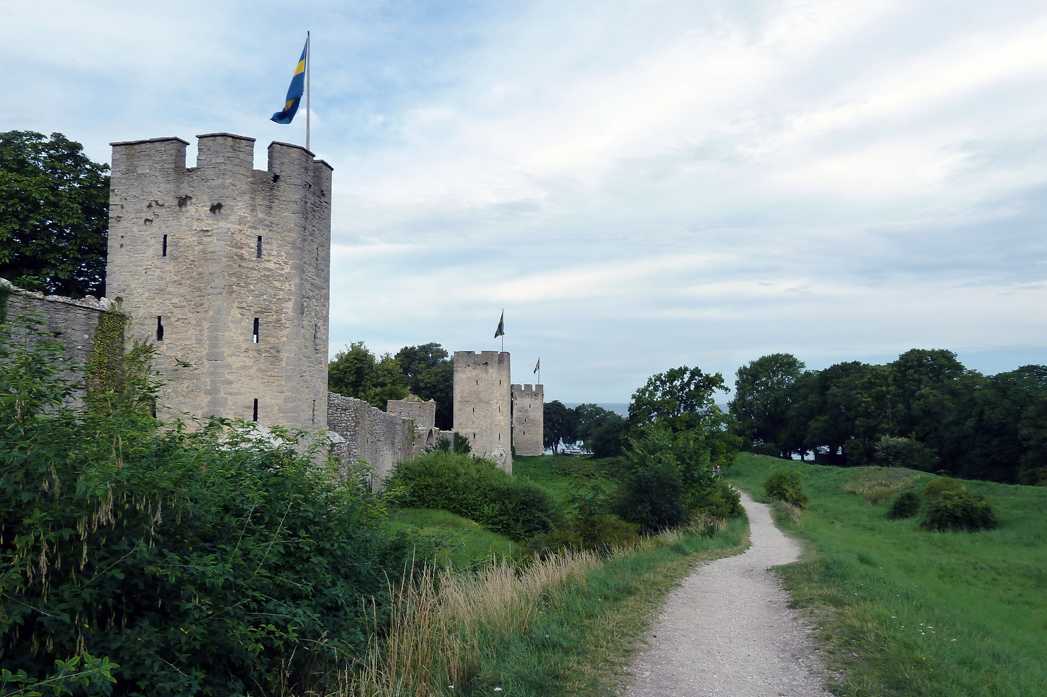February 2012 more than 90 m2 of the wall around Visby crumpled to earth. Now the wall has been repaired using medieval techniques, kept alive in the countryside.
 When part of the medieval wall around Visby slid to the ground in February 2012, it felt like a foreboding of worse to come. The impressive wall, which is a long medieval defensive wall from the 13th century, is World Heritage and is constantly monitored by the Swedish National Heritage Board. When the collapse took place, archaeologists had recently examined the wall. Nevertheless, this particular weak part had not been discovered. It is generally felt, that more will come.
When part of the medieval wall around Visby slid to the ground in February 2012, it felt like a foreboding of worse to come. The impressive wall, which is a long medieval defensive wall from the 13th century, is World Heritage and is constantly monitored by the Swedish National Heritage Board. When the collapse took place, archaeologists had recently examined the wall. Nevertheless, this particular weak part had not been discovered. It is generally felt, that more will come.
This is one of the reasons why the rebuilding was carefully thought through from the beginning. How to proceed was also a matter of gaining valuable experience in order to be prepared for the next time.
The Construction of the Wall
 The city wall as it stands today is 3.44 km. long (originally it measured 3.6 km. Originally there were 29 large towers and 22 small wall-towers riding on top of the wall. Today 27 large towers and 9 of the smaller ones remain. Essentially begun in the 13th century it was finished in 1361, when the Danish king Valdemar Atterdag defeated an army in front of the gates and conquered the city.
The city wall as it stands today is 3.44 km. long (originally it measured 3.6 km. Originally there were 29 large towers and 22 small wall-towers riding on top of the wall. Today 27 large towers and 9 of the smaller ones remain. Essentially begun in the 13th century it was finished in 1361, when the Danish king Valdemar Atterdag defeated an army in front of the gates and conquered the city.
The City wall around Visby was thus an on-going building-project. The first wall was made as a lower three-leaf wall with two shells built of limestone and fat lime mortar and a soft and porous rubble core of limestone and clay mortar. The second wall was built higher and on top of the old wall. Materials were mainly limestone and lime mortar. However, in the 20th century a number of restorations had taken place, using strong cement mortar. It soon became apparent that the collapse of the wall was a reflection of the use of these modern materials and techniques.
In order to describe and analyse the construction a number of modern techniques were applied: laser-scanning, 3D-reconstruction, microscopic analysis of specimens. To this should be added a careful and detailed examination of the wall.
During this exploration of the properties of the wall, a number of restoration techniques were tried out. However, in the end it was decided to simply use the ancient materials, the local limestone from nearby. (As is a series of other medieval stone-buildings on the island of Gotland.) The reason was that the archaeologists discovered that the more modern materials (cement mortar) were less porous. Thus moisture had tended to be caught in the recesses of the wall. In the weeks leading up to the disaster there were a series of shifts in the weather alternating between freezing and thawing. Ultimately this led to the crumbling wall.
The reconstruction of the wall, which officially began in 2014, thus led to a “rediscovery” of the ancient medieval techniques, which luckily were still applied by locals today. For instance, mixing quicklime (burnt lime) with sand and fat according to ancient recipes produced the mortar, which was used in the reconstruction.
Medieval Quicklime
Production of quicklime had been going on at Gotland well into the 1950s and ethnologists, trying to document the old techniques, had a series of films made. These films document how quicklime was produced. First you dig a whole in the earth and line it with boards. Next step is placing the burnt limestones in the grave. Afterwards it must be covered with a layer of boards and on top of that a layer of fresh horse-manure. It takes about 2 – 5 years to get quicklime out of this. This produces a rather coarse-grained lime, which has to be “whipped” in order to be so smooth that it can be mixed with sand. This kind of lime is rather coarse and
These – and other – discoveries have inspired the project to run a series of workshops, teaching building restorers from all over Europe how to explore and use old limekilns and techniques.
The reconstruction of the wall has cost € 950.000
Source:
Construction and Materials of Visby medieval city wall – risk of damage.
By Kristin Balksten and Carl Thelin
Paper presented in Guimarães at the 9th International Masonry Conference 2014
READ MORE:
Visby Ringmur – Kulturarv som rasar och återuppbygs
(Visby Wall – Heritage which collapses and gets rebuilt)
By Kristin Balksten and Ulrika Mebus
Published by the Swedish National Heritage Board 2015-05-04
